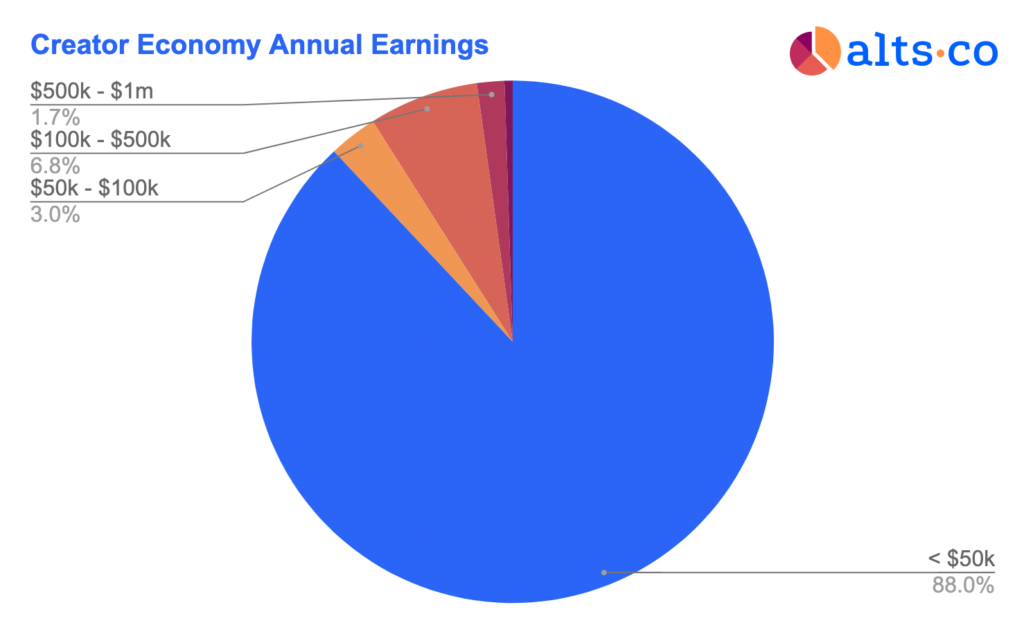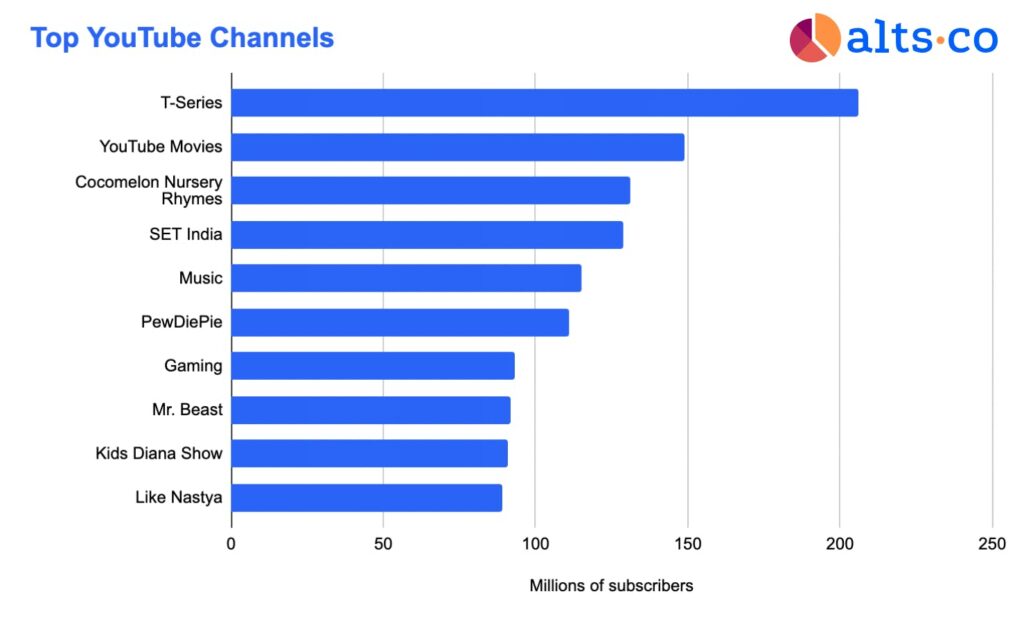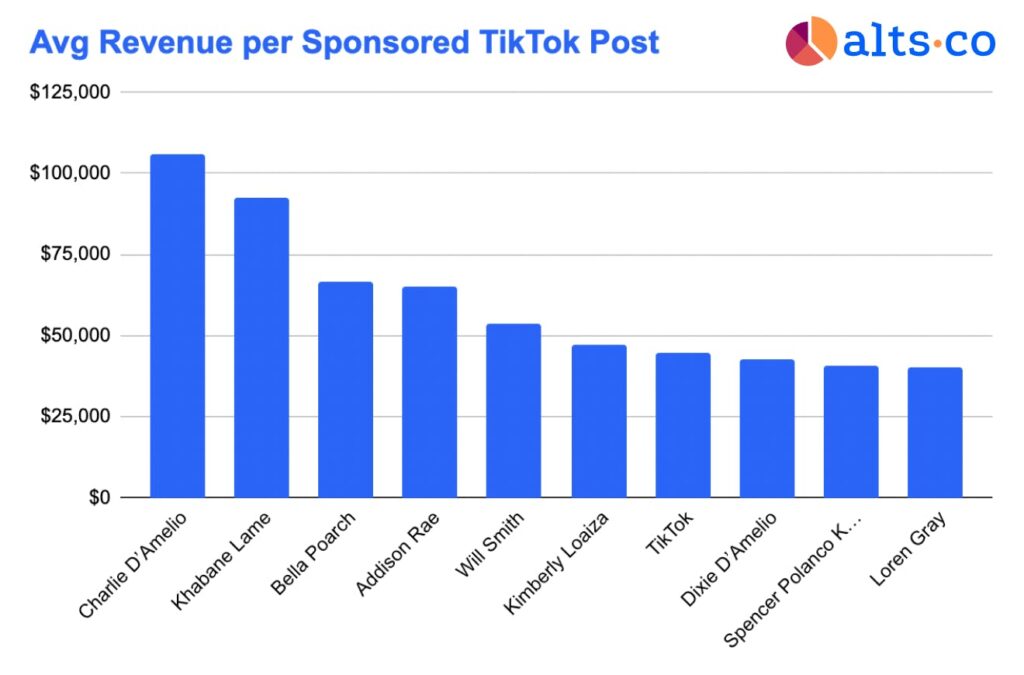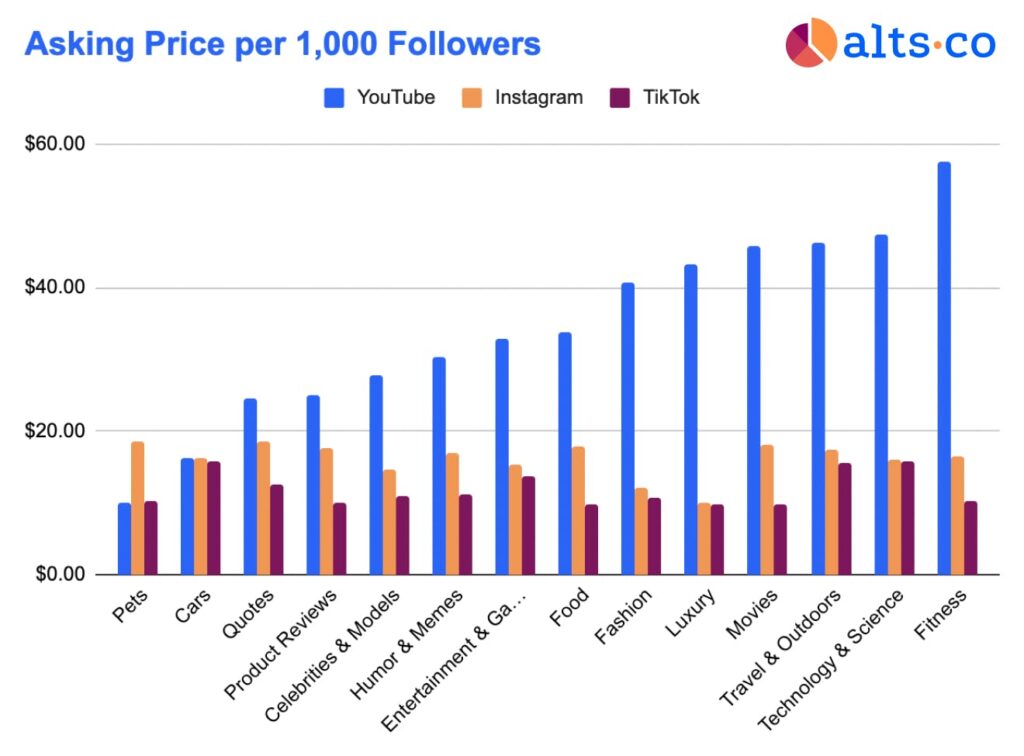Creator earnings probably aren’t what you think.
While web3 opens new ways for creators to earn, social media still mostly lives in a web2 world. And to keep going in this world, creators need to make the numbers work. It’s exactly these social media economics that we’ll look at today.
Table of Contents
Creators are grumbling
One of the lesser discussed topics during this downturn has been the effect on the creator economy.
Nate O’Brien, whose YouTube finance channel has 1.2m subscribers, put it this way:

Now, this is far from hard data, and the replies are full of anecdotes from agencies claiming their experience has been different. But Nate isn’t the only one who has noticed a shift in spending. Plenty of others are talking about a creator economy recession, and in the web3 space, a creator economy winter.
If we are in a creator economy recession, it’s likely a heavy pendulum swing back from last year’s highs. A ton of new creators entered the market during covid. According to Stripe, in 2021 the number of creators shot up 48%. Creators and agents took advantage of the gold rush, and CPMs (the price creators command from sponsors & ads) skyrocketed.
Today, brands still have an appetite, but increased competition is driving down prices, and incumbent creators are likely feeling the crunch. Like with so much else, prices are coming back down to earth. We’re seeing the market become more efficient.
Just how big is the creator economy anyways? Probably bigger than you think. Nate has surprisingly large company; there are about 23,000 channels with over a million subscribers.
But it all depends on how you define it.
How big is the creator economy?
The problem with defining the creator economy is that its so broad. YouTube, Instagram, and TikTok are clearly part of it, sure. And podcasts and newsletters.
But what about Spotify? Are musicians creators? What if they aren’t independent? What about Etsy stores? Or Amazon publishers? Or content sites?
And on and on we go. Where do you draw the line?
One could argue that anyone who produces content and/or digital goods should be counted, from part-time micro-influencers to full-time mega-creators. By this absurdly large measure, there are an estimated 200 million creators, contributing to a $105 billion dollar industry (roughly equivalent to the GDP of the fifty lowest countries combined.)
Less aggressive calculations peg the number at around 50 million creators. In this issue, we’ll focus on the three most common creator platforms: YouTube, Instagram, and TikTok.
Creator earnings
Data on creator earnings is all over the place. But I cobbled together a few different sources (including Hubspot, VDOcipher, and Influencer Marketing Hub) to triangulate.
Of the 50 million creators worldwide…
- 92% (46m) consider themselves amateurs, and 8% (4m) consider themselves pros
- Only 4% (2 million) consider themselves pros and report making a “good living”
- 88% (44m) earn less than $50k/year
- 3% (1.5m) earn between $50k – $100k/year
- 6.8% (3.4m) earn between $100k – $500k/year
- 1.7% (850,000) earn between $500k – $1m/year
- 0.5% (250,000) earn over $1m per year

YouTube economics
YouTube is the best way to earn as a creator.
There are roughly 37 million YouTube channels, and YouTube claims 12 million creators – about 1 in every 3 channels. Nearly half of the 2 million “pro” content creators earn their money on YouTube.
Clubhouse was the poster child for pandemic hype, but YouTube is what really took off during this time. In 2020 there were around 22,000 YouTube channels with over 1 million subscribers, up 65% YoY. And about 600 channels have 10 million+ subscribers.

YouTube splits ad revenue with creators, giving them 55% and keeping 45% for themselves. This seems high, and they get some flack for it.
But it’s very easy to get started. YouTube paid creators more than $15 billion in 2021, and just announced they’ll be monetizing YouTube Shorts as well.
YouTube stats
- Avg revenue per video: $21 per 1,000 views
- Top 50 median follower count: 56 million
- Top 50 median sponsorship price per video: $1.1m
- Highly international. 22% from USA, 42% from India & Asia
- 78% of the top 50 channels are music, film, or entertainment-related
- Top 10 creators receive 2% of all payouts — about $300m/year (!)
Despite the stratification, YouTube can be disproportionally lucrative, even if you’re not a top creator. The example below claims earnings of $35k from a single video on YouTube — 10x higher than what you can get slaving away for a year on TikTok.
As stated above, long videos monetize best on YouTube because they can be stuffed with ads. This is why every YouTube video is almost exactly 10 minutes long. When a video is at least 10 minutes long, you can add mid-roll ads (ads shown halfway through the video) in addition to pre-roll (ads at the beginning of the video). More ads = more money.
Yes, this video is just over 10 minutes long.
But top creators report the best way to earn money is to contract directly with brands. Sponsorships are where the real money is made.
And since Instagram doesn’t share revenue with creators, sponsorships are essentially what power the entire Instagram influencing economy.
Instagram economics
If it seems like there’s a fu*kload of influencers on Instagram, it’s because there are. Instagram is second behind YouTube, with about 500,000 professional influencers on the platform.
But what Instagram has is the most wannabe creators (i.e., “micro-influencers”). There are 1.3 billion Instagram accounts, and roughly 30 million of these are from micro-influencers with over 1,000 followers.
If these micro-influencers formed a country together, it would be the 49th most populated country on earth (and absolute hell to visit) 🤳

The folks over at HopperHQ published a “Rich List” which shows how much the top Instagram accounts charge per sponsored post. I exported all the data and did some interesting analysis:
Instagram stats
- Avg revenue per post: $5.30 per 1,000 followers (compared to $21 for YouTube)
- Top 50 median follower count 80m (50% higher than YouTube)
- Top 50 median price per post of $437,000 (60% lower than YouTube)
- USA-centric. 64% of the top 50 accounts are from the USA, just 4% from India & Asia
- 31% of the top 50 accounts are celebrities, and 26% are athletes
- ~30 million accounts have 1,000+ followers (“micro-influencers”)
- 500,000 accounts have 100,000+ followers (100k is usually considered the floor for “influencers”)
- 30,000 accounts have 1 million+ (compared to 23,000 on YouTube)
Instagram’s top accounts are all the usual suspects: Athletes, celebrities, singers, and actors. But what’s fascinating is just how lucrative sponsored posts can be for top influencers.
With 476m followers, Cristiano Ronaldo (Instagram’s most-followed account) can earn over $2m for a single sponsored post.

In fact, The Hustle found that LeBron James could earn more for a sponsored post than he earns per NBA game!
For anyone who wants to see it, here’s the full data set,
TikTok economics
TikTok is an undeniable force. The bane of parents everywhere, and the music industry’s current lightning rod.
Chartr had some great charts showing their massive spending on BDSM (Business Development, Sales & Marketing) 😂
And Dan Runcie at Trapital broke down their plan to take over music.

But interestingly, despite TikTok’s inevitable social media domination, creator payouts on TikTok are surprisingly…not lucrative. A 2021 survey from SocialBlade found TikTok creators earned $20,400/year, compared to $46,800 on Instagram and $49,200 for YouTube.
TikTok stats
- Avg revenue per post: $0.71 per 1,000 followers (86% lower than Instagram!)
- Top 50 median follower count 41m (50% lower than Instagram)
- Top 50 median price per post of $28,670 (93% lower than Instagram!)
- 46% of top 50 accounts are from USA, 14% from India & Asia (More global than Insta)
- 32% of top 50 accounts are celebrities, none are athletes
- 39 million accounts have 1,000+ followers (more than YouTube and Instagram, despite TikTok being far younger)

These numbers are really interesting. In a nutshell, TikTok followers are worth less. The top TikTokers have half the follower count of top Instagrammers, but receive just 6.5% as much revenue!
What TikTok does well is get lots of people oodles of followers, and quickly. TikTokers can get huge overnight. It gives the small guy a chance. This is why many people don’t recognize most of the top 10 accounts.
But fortunes change. After all, there is only so much attention to go around. For TikTok, turning “15 minutes of fame” into an app has diluted the million-follower accomplishment. New flavors of the month week are cropping up every day. And TikTokers gripe about falling out of favor with the algorithm all the time.
Your TikTok views are dropping because your 15 minutes are up, pal! Time to move to YouTube and make a (ten-minute) video about it. This guy gets it. ☝️
This is probably why so many TikTokers are trying to sell their accounts..
Social media account valuations
While Ronaldo and the D’Amelio sisters won’t be selling their accounts anytime soon, plenty of small creators put their accounts up for sale.
In our previous issue on buying and selling social media accounts, we explored how you can actually purchase other people’s social media accounts, through platforms like Fameswap.
Over the past year, we’ve been tracking the stats & asking prices of social media accounts for sale across the various marketplaces (About 24,000 total).
Here’s a sample of what we’ve found:
YouTube channel valuations
YouTube has the highest asking prices (as well as the highest price per 1,000 followers).
- Median audience size: 27,900
- Median asking price: $1,000
- Median asking price per 1k followers: $31.78
Instagram account valuations
Instagram accounts are lower across the board. The fact that the median audience size is half of YouTube’s shows that Instagram accounts attempt to sell earlier.
- Median audience size: 14,800
- Median asking price: $250
- Median asking price per 1k followers: $15.96
TikTok account valuations
TikTok accounts are bottom of the barrel: An account with 100k followers can reasonably expect to sell for just $1,100
- Median audience size: 44,200
- Median asking price: $550
- Median asking price per 1k followers: $11.11

If all of these asking prices seem low, remember that:
- Lots of these followers are bots, and
- Follower counts don’t really matter anymore, and
Followers is a vanity metric that has been consistently abused by bots. And as we’ve seen with TikTok, it’s actually pretty easy to get a large audience rather quickly. One viral video will pretty much do it. (According to a comprehensive report from Contraband, musicians that have a song go viral on TikTok receive an average of 300,000 followers!)
Social media account marketplaces are littered with accounts that had one viral video; a success they could never again replicate. They eventually moved on and decided to sell the account for whatever they could.
What matters is not followers, but influence. Influence isn’t how many followers you have. It’s your ability to move mountains. To quote Rage Against the Machine, “You say jump, they say how high.”
Ultimately, it’s the ability to consistently show your sponsors a decent return (especially during a creator winter.) That’s all it really comes down to.
Creator funds
Platforms know not everyone will be a superstar. But they also understand it’s in their best interest to give hope to fresh blood.
- TikTok was first. They launched a mega $200m fund back in 2020
- LinkedIn just announced a $25m fund via its Creator Accelerator Program
- Pinterest recently launched a $500,000 creator fund
- Instagram is now paying publishers to create Reels
- YouTube just added a $100 million fund just for Shorts, its TikTok-like feature
Closing thoughts
Creator marketing recognizes that the old ways of advertising don’t work like they used to. Traditional Facebook/Instagram advertising has become both more expensive and less scalable. CAC has increased, forcing brands to reach the younger generations through sponsored content.
Professional influencers can command huge sums for sponsored posts/videos, and software like Influenceli makes everything easier to manage. But it’s a tough game, with enormous power laws and low chances of success. Even on YouTube, the most lucrative platform, 800 million videos are fighting over $15 billion in annual payouts.
Like most markets, prices on the high end have held up well. If you’re a business looking to sponsor creators, consider using micro-influencers. Millions of followers are no longer necessary. With authenticity being valued more than ever, creators who create a genuine connection with an engaged audience will do just fine.
Another tip for businesses is to just scoop up social media accounts yourself. There’s a pretty sizeable knowledge gap for creators who don’t really understand the value of their own content and audience, and these accounts are sold on incredibly imperfect marketplaces. It won’t be on your typical list of creator economy trends, but trust me: it’s one of the biggest growth hacks nobody talks about.
What’s next for the creator economy? Besides increased competition and 15 20 minutes of fame (thanks to TikTok), one interesting idea is AI-generated influencers. Why spend all that time creating content yourself when you can use software to do it for you. It’s already happening. Don’t believe me? Here’s a list of 35 verified virtual influencers 😲













